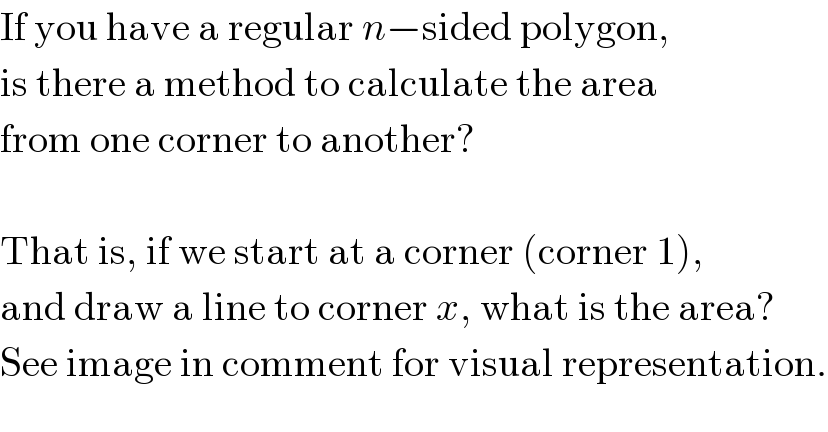Question Number 5515 by FilupSmith last updated on 17/May/16

Commented by FilupSmith last updated on 17/May/16

Answered by Rasheed Soomro last updated on 17/May/16

Commented by Rasheed Soomro last updated on 19/May/16
![Region ABCDE=Region ABCDEO−▲AEO In general, if first corner is A_1 and xth corner (upto wbich area is required and of course 0<x<n for n-gon) is A_x then, Region A_1 A_2 ...A_x =Region A_1 A_2 ...A_x O−▲A_1 A_x O Region A_1 A_2 ...A_n O consists of x−1 isosceles triangles in general (only in hexagon these triangles are equilateral).If polygon is n-gon each of these triangles has ((360)/n) degree angle at centre (O) of polygon and △A_1 A_x O has (x−1)(((360)/n)) dgree angle at O. Let radius of the polygon is r Each triangle in Region A_1 A_2 ...A_x O has area: ▲=(1/2)r^2 sin ((360)/n) Region A_1 A_2 ...A_x O consist of x−1 such triangles So, Region A_1 A_2 ...A_x O=(x−1)×(1/2)r^2 sin ((360)/n) =(1/2)r^2 (x−1) sin ((360)/n) And now ▲A_1 A_x O=(1/2)r^2 sin ((360(x−1))/n) So finally Region A_1 A_2 ...A_x =Region A_1 A_2 ...A_x O−▲A_1 A_x O =(1/2)r^2 (x−1) sin ((360)/n)−(1/2)r^2 sin ((360(x−1))/n) = (1/2)r^2 [(x−1) sin ((360)/n)−sin ((360(x−1))/n)]](https://www.tinkutara.com/question/Q5527.png)
Commented by FilupSmith last updated on 17/May/16

